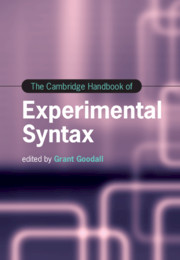Book contents
- The Cambridge Handbook of Experimental Syntax
- The Cambridge Handbook of Experimental Syntax
- Copyright page
- Contents
- Figures
- Tables
- Contributors
- Introduction
- Part I General Issues in Acceptability Experiments
- Part II Experimental Studies of Specific Phenomena
- Part III Experimental Studies of Specific Populations and Language Families
- 14 Acceptability Studies in L2 Populations
- 15 Judgments of Acceptability, Truth, and Felicity in Child Language
- 16 Acceptability and Truth-Value Judgment Studies in East Asian Languages
- 17 Acceptability Experiments in Romance Languages
- 18 Acceptability Studies in (Non-English) Germanic Languages
- 19 Acceptability Studies in Semitic Languages
- 20 Experimental Syntax and Slavic Languages
- 21 Acceptability Judgments in Sign Linguistics
- Part IV Experimental Syntax beyond Acceptability
- Index
- References
15 - Judgments of Acceptability, Truth, and Felicity in Child Language
from Part III - Experimental Studies of Specific Populations and Language Families
Published online by Cambridge University Press: 16 December 2021
- The Cambridge Handbook of Experimental Syntax
- The Cambridge Handbook of Experimental Syntax
- Copyright page
- Contents
- Figures
- Tables
- Contributors
- Introduction
- Part I General Issues in Acceptability Experiments
- Part II Experimental Studies of Specific Phenomena
- Part III Experimental Studies of Specific Populations and Language Families
- 14 Acceptability Studies in L2 Populations
- 15 Judgments of Acceptability, Truth, and Felicity in Child Language
- 16 Acceptability and Truth-Value Judgment Studies in East Asian Languages
- 17 Acceptability Experiments in Romance Languages
- 18 Acceptability Studies in (Non-English) Germanic Languages
- 19 Acceptability Studies in Semitic Languages
- 20 Experimental Syntax and Slavic Languages
- 21 Acceptability Judgments in Sign Linguistics
- Part IV Experimental Syntax beyond Acceptability
- Index
- References
Summary
Researchers who study child language have a range of tasks available to them for assessing children’s linguistic knowledge and development.Research findings have shown that sentence acceptability tasks are extremely challenging for children younger than 6 years of age. Pre-school children who are ”metalinguistically aware” can succeed, but most children require the addition of contextual support to demonstrate the intended meaning of the sentence. Instead, many experiments opt for truth-value judgment tasks which can be used successfully with children as young as 3 years old. Truth-value judgment tasks can also incorporate a check on children’s interpretation of the test sentence. Two new tasks, the felicity judgment task and the ternary judgment task, have evolved recently to assess children’s pragmatic inferences. The efficacy of the ternary judgment task has not yet been demonstrated but the felicity judgment task has been used reliably, and can reveal the source of children’s decisions, by presenting explicit alternatives as the basis of the child’s decision.
Keywords
Information
- Type
- Chapter
- Information
- The Cambridge Handbook of Experimental Syntax , pp. 394 - 420Publisher: Cambridge University PressPrint publication year: 2021
References
Accessibility standard: Unknown
Why this information is here
This section outlines the accessibility features of this content - including support for screen readers, full keyboard navigation and high-contrast display options. This may not be relevant for you.Accessibility Information
- 1
- Cited by
